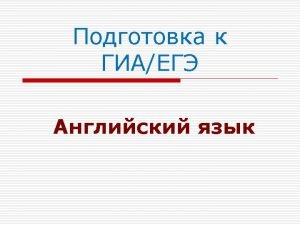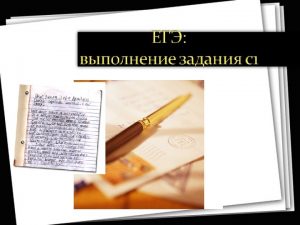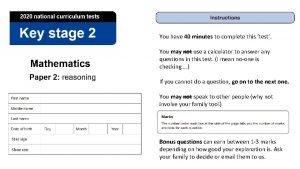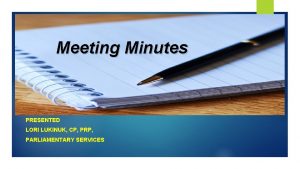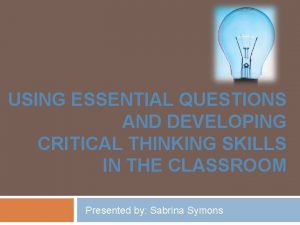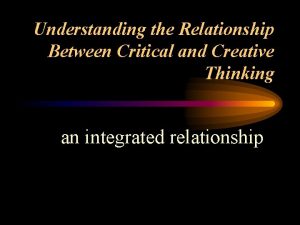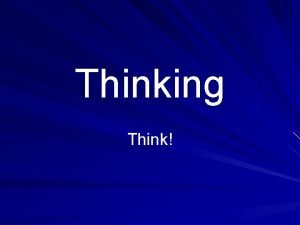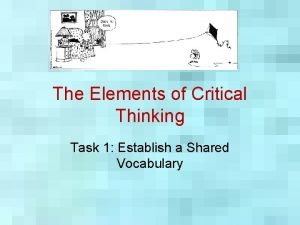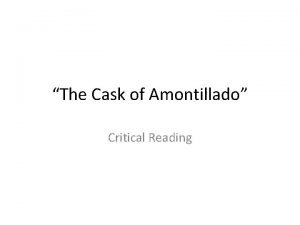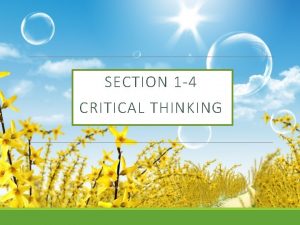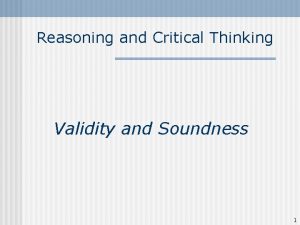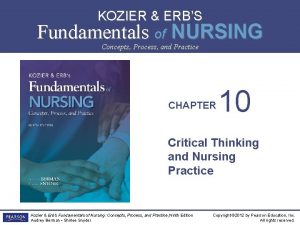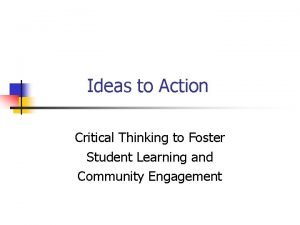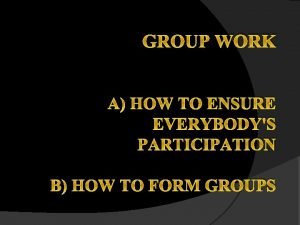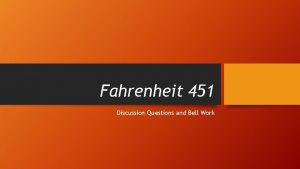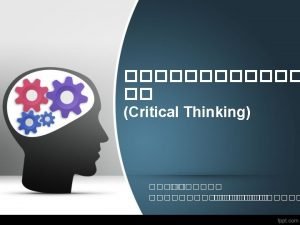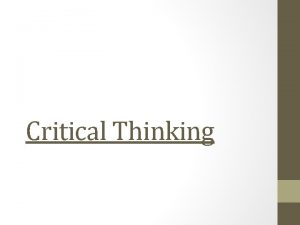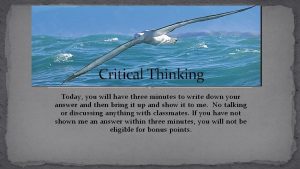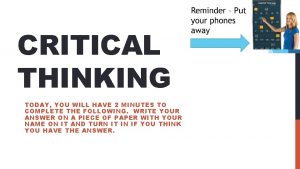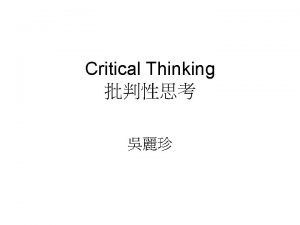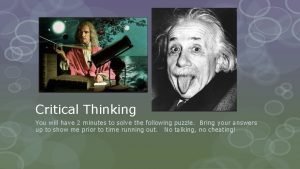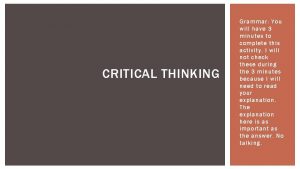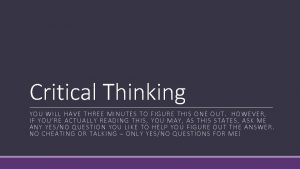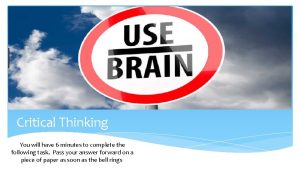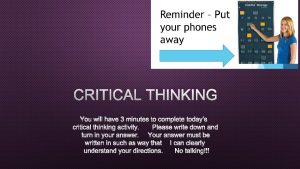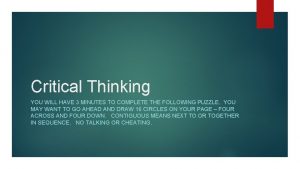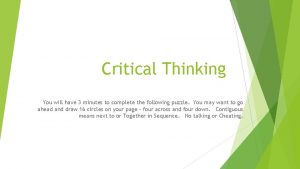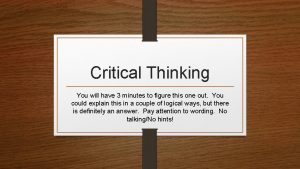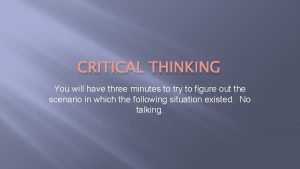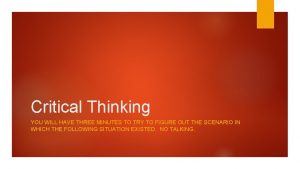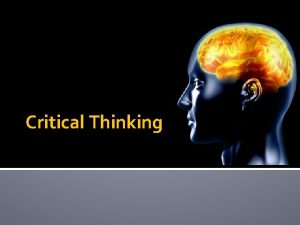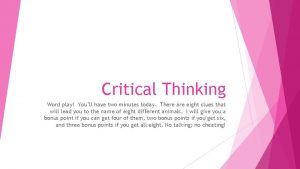Critical Thinking Today you will have 2 minutes







































- Slides: 39

Critical Thinking Today, you will have 2 minutes to complete the task. Come up and show or tell me the answer. No more than three guesses today. I will not take any more answers once the buzzer goes off signaling that 2 minutes has expired. No Talking!


ANSWER: Answer : Q Explanation : Adding the three numbers in each square together gives the numerical value of the letter at the center of each square.

Today’s Goals I can use diction to help me express an attitude (without explicitly stating the attitude). I can identify the first three major premises on which we will build this course.

Today’s Goals I can use diction to help me express an attitude (without explicitly stating the attitude).

Voice Lessons – Diction Consider: The man sighed hugely. - E. Annie Proulx, The Shipping News Discuss: 1. What does it mean to sigh hugely? List other words that might describe a huge sigh. 2. How would the meaning of the sentence change if we rewrote it as: The man sighed loudly. Apply: Fill in the blank with an adverb: The man coughed ______. Your adverb should make the cough express an attitude. For example the cough could express contempt, desperation, or propriety. Do not state the attitude. Instead, let the adverb imply it. Once you have it – write a sentence or two explaining the attitude you were hoping to express.

Today’s Goals I can identify the first three major premises on which we will build this course.

Major Premises in this Class…So Far 1. 2. Diction – Words Matter. Good writers are very thoughtful when choosing words. All nonfiction texts are part of a broader conversation. • Can you identify the conversation that has been taking place with the articles we summarized last class? • Why might it be important to know what the conversation is?

Stasis Theory Stasis is the fixed point upon which an argument hinges. In his book The Shape of Reason: Argumentative Writing in College, author John Gage explains “the stasis of any argument is the specific point on which the controversy rests – the point on which one person says ‘yes’ but another person says ‘no’ or ‘I’m not sure’. ” If we can’t settle on a point of disagreement, we can’t engage in argumentation because we’re either talking on cross-purposes or talking to ourselves. Example: A group wants to discuss why capital punishment is morally wrong, but an individual jumps into the conversation and begins to evaluate the financial costs of capital punishment. These people are not in stasis – they are not part of the same conversation. To engage an audience, we need to achieve stasis.

Continuing the idea of stasis… Let’s go back to rule 2 that all texts are part of a broader conversation. Let’s examine stasis one more time but with Malcolm Gladwell’s Outliers this time. Let’s once again assume he’s part of a broader conversation and we want to be a part of that conversation. Let’s begin the way you likely would have before this class: jump right in! IF I asked you to agree or disagree with Gladwell? Most of you would have had strong opinions. Why? Why might jumping right in and arguing with Gladwell be foolish? Maybe even get us laughed at? Is Gladwell talking about mere success for you and me? What’s he talking about? What is the question driving the conversation he is having? Stasis – How do the Outliers of society achieve such great success? How would this have shifted your argument in summer essay?

Major Premises in this Class 1. 2. 3. Diction – Words Matter. Good writers are very thoughtful when choosing words. All nonfiction texts are part of a broader conversation. Good writers use the best possible means of making their argument – this is called rhetoric. • Why might I introduce the idea of stasis with this 3 rd premise? • How might someone who understands both of these last two concepts use them in a deceitful way? So hopefully, you see that theory of stasis ties into our 2 nd and 3 rd premise: • If we are claiming that good writers use the best means possible (sometimes any means) to improve their argument, is it possible that people purposely use deceitful methods to shift the narrative in their favor? We must be clear on the argument at hand. • When we get to argument, we can’t argue if we’re not sure what the conversation is. • As we begin to analyze the rhetoric writers use, we must understand the conversation to effectively evaluate an author’s rhetoric.

Rule 3 - Good writers utilize the best possible means to make their argument. This is called rhetoric!! We will have to learn what the tools and trick are. We will have to learn how and why authors use these tools. We will want to begin using these tools ourselves as we aim to become better writers. But first we’ve got to cross a threshold – we must learn to pay attention. Things to Think About 1. How many of you always thought writers just sit down and write? 2. How many of you knew there were tools used by good writers and knowing those rules could open up an entirely new understanding of a text? 3. How many of you are willing to take the time to see what’s beneath the surface?

Quick Informational Items I’ve given a grace period on late homework so far. Starting Monday, you will receive a 30% penalty for work turned in late – regardless of the reason. Please pay attention to due dates. If you miss school, please check the work you missed on the website. Don’t wait until class to come and get work – use third period or passing periods to come get anything you need the next day. Also, check in when you don’t understand. Many of you are stressing over things that are easily clarified and often not worth stressing yourself out over. If you get behind or don’t understand, don’t hide – ask for help. Vocabulary Quiz Grade – 3 week average. Insert now or later? Leadership opportunity – Peers Project ESL – Multicultural Club

Discussion: The Shallows Summaries What problems are you coming across? How do you determine the main idea when there seems to be multiple ideas? Where can you look for hints about the main ideas? What are some of the qualities of a well-structured argument?

Quick Vocabulary Quiz 1. Open to Socrative 2. Login to Bauer 2016 3. Type your first name and last name 4. You have exactly five minutes to complete the quiz.

Homework 1. Complete Voice Lesson if needed – we will turn them in on Monday, so have them with you. 2. DUE MONDAY - Read pages 1 -6 AND 39 -44 in your Language of Composition book. 3. DUE TODAY – Read chapters 3, 4, 5, and 6 of The Shallows and write a summary for each chapter. 4. DUE WEDNESDAY – Read chapters 7, 8, 9, and 10 of The Shallows and write a summary for each chapter.

Today’s Goals I can identify the first three major premises on which we will build this course.

Learning to Pay Attention Consider how many times you’ve heard a song on the radio and didn’t really love it. But, after hearing it 5 -10 times on the radio, you’re tapping your foot and starting to hum along. Then, another 5 -10 listens and you’re singing along to every word, you’re thinking about what the song means, and you love everything about it. The most difficult issues in our city, state, country, and world aren’t likely to be solved without deep thought and much consideration. Are you willing to pay attention to the conversation taking place? Let’s find out!

See – Think – Wonder Routine We will use this routine often. Begin by SEEing what is literally in front of you first – harder than it sounds. Begin to THINK about what you see and how the things you see fit together. WONDER and question what all of these things might mean. Check to see if the meaning works with what you are seeing. Draw some conclusions.

Learning to Pay Attention Together, we’re going to look closely at a painting for a full ten minutes. Although our task today is not really to determine the meaning of the painting, I want you to pretend that for the next ten minutes, we are looking at this painting with the goal of trying to discover the meaning of the painting. However, to do this, your immediate task is to SEE every little detail you can see during the allotted time – at this phase, don’t bother thinking about the why. As you notice a detail, and write it down and note which minute you noticed it.

The Temptation of St. Anthony

One thing we know for sure: “Just because something is available instantly to vision does not mean that it is available instantly to consciousness. ” There is Power in Patience – Jennifer Roberts teaches an entire class at Harvard titled – Power in Patience: Teaching Students the Value of Deceleration and Immersive Attention. She has a Ph. D from Yale, has taught at Harvard for over 30 years and has taught classes on the Power of Patience to US Presidents, foreign world leaders, and some of the top FBI, CIA, military, and civilian minds in the country.

So how does this relate to close reading in a rhetoric and argument class? Just because you read it, doesn’t mean you fully understand it or even touched the surface of the meaning. If you want to join the conversation or even have a seat at the table, it will require some patience to understand what conversation is being had AND what people are saying about the topic at hand. Listening to a text and postponing judgment requires much more brain muscle (and good manners) than simply responding to the first thing that comes to mind. Thinking of a text as a conversation, we’re not just waiting our turn to respond, we’re engaging in reading as discovery, searching for the questions other writers are asking. We must comprehend a text before we critique it. If we jump into a conversation and contradict what’s being said before we fully understand it, we often look foolish; therefore, if a text is merely a part of a conversation, it will be wise to try to grasp what’s being said before we respond.


Harvard University art historian Jennifer L. Roberts – The Power of Patience What she saw: What she wondered: 9 min – the shape of the boy’s ear precisely echoes that of the ruff along the squirrel’s belly. Is there some kind of connectedness between the animal and the human body? Maybe the sensory capacities of each because of the ear. Is there a comment on human relationship with and reliance upon water? Has Copley imagined those sensory organs distributing or imprinting themselves on the surface behind him? 21 min – the fingers and thumb holding the chain exactly span the diameter of water glass beneath them. 45 min – seemingly random folds and wrinkles in the background curtain are actually perfect copies of the shapes of the boy’s ear and eyes




It’s important to listen closely… By paying close attention, we will find that writers may be doing things beneath the surface that can add deeper meaning to a text. What do I see the author doing? What do I wonder about the things I see? What do I not see the author doing or saying? Has the author purposefully left things unsaid? What tools has the author used? Do I know why the author chose these tools?

Major Premises in this Class 1. 2. 3. Diction – Words Matter. Good writers are very thoughtful when choosing words. All nonfiction texts are part of a broader conversation. Good writers use any means possible to improve their argument – this is called rhetoric. How does this process tie in with the 2 nd and 3 rd premise of our class?

Quick Break – Are you sold on threshold yet? Are you ready to begin to break through it? If so, the next step is to begin to really listen closely to a text. The goal is always to figure it out entirely or as close to entirely as possible; however, even when this can’t occur, a slow, careful approach where you listen closely will help your understanding tremendously. We do this through a process called “Close Reading. ” There are many ways to conduct close readings.

Learning To Pay Attention See – Think – Wonder Routine We will use this routine often. Begin by SEEing what is literally in front of you first – harder than it sounds. Begin to THINK about what you see and how the things you see fit together. WONDER and question what all of these things might mean. Check to see if the meaning works with what you are seeing. Draw some conclusions.

“The Olympic Contradiction” by David Brooks – New York Times Follow along as I read aloud. Listen to my thinking as I stop after every couple paragraphs. As you listen to my thinking, keep track of what I am doing as I’m playing the believing game. This checklist is for two different games, so not all items will be checked. Place a + next to each item you hear me demonstrating during my think aloud.

The Olympic Contradiction SEE: Read the text. Annotate, highlight, pay attention to detail. At this point simply try to pay close attention and notice what’s there. THINK: What is there? Does anything stand out? Is anything unusual? Does anything seem out of place? Does he seem to emphasize anything? WONDER: Begin asking questions. Write them down. What do you wonder about some of the things Brooks said or did? There is no right or wrong…. what do you wonder?

Stasis Write your name on the notecard I just passed out. Identify the central question Brooks responds to in “The Olympic Contradiction. ” Then explain why you chose the answer you selected. A. Can competitive virtues coexist with cooperative virtues? B. What is the reason for the enduring popularity of the Olympics? C. Is dance a true sport? D. Is an acceptance of opposites a characteristic of intelligence? E. Is it good to embrace the tension between contradictions? F. Is competition better than cooperation? G. Should the Olympic Games be less competitive? * Remember to justify your answer.

Bringing the Conversation to Life Homework: Draw a sketch representing all the different voices you hear in David Brook’s “The Olympic Contradiction. ” You may want to conduct a quick Internet search for images of the people Brooks mentions in his article to see what they look like. These are the people who have contributed something to the conversation he’s joining. Be sure to include Brooks himself in your sketch. Stick figures are fine – the point is for you to be able to see these references or sources are real people.

1. 2. 3. 4. Define it – we have to know what it is. Identify it – we have to be able to recognize it within a text. Analyze it – we have to understand with what purpose it is used. Use it – we have to be able to utilize it effectively in our own writing. Continue to Review Academic Vocabulary

Homework 1. Turn in Voice Lesson if you didn’t. 2. Draw a sketch representing all the different voices you hear in David Brook’s “The Olympic Contradiction. ” You may want to conduct a quick Internet search for images of the people Brooks mentions in his article to see what they look like. These are the people who have contributed something to the conversation he’s joining. Be sure to include Brooks himself in your sketch. Stick figures are fine – the point is for you to be able to see these references or sources are real people. 3. Read pages 1 -6 AND 44 -54 in your Language of Composition book. 4. DUE TODAY – Read chapters 3, 4, 5, and 6 of The Shallows and write a summary for each chapter. 5. DUE WEDNESDAY – Read chapters 7, 8, 9, and 10 of The Shallows and write a summary for each chapter.

Discourse Communities We all have communities or groups that we feel like we belong to. Typically communities have their own jargon (language that’s unique to the group) that they use to communicate. Think of a group that you feel like you belong to and brainstorm words that might be unique to your community. Example: Track Me – Hey man, you ready to hit that interval workout today? Trey – Yeah, last time you had me running quarters I hit a wall after four though. Me – I know, but if you want that medal on the big stage, you’re going to have to push through the pain. Trey – I am definitely making it to the podium this year. If I can just keep putting up PRs each meet, I know I’ll be there. Me – We not only need to get you there, we need to get in the fast heat, so you have more rest time between trials and finals. Go get your dynamics and some strides in and let’s get this workout started.
 Critical semi critical and non critical instruments
Critical semi critical and non critical instruments Spaulding classification system
Spaulding classification system Perbedaan critical thinking dan creative thinking
Perbedaan critical thinking dan creative thinking 60 seconds 1 minute 60 minutes 1 hour
60 seconds 1 minute 60 minutes 1 hour What language
What language You have 30 minutes to do this task
You have 30 minutes to do this task You have 20 minutes to do this task
You have 20 minutes to do this task You have 20 minutes to do this task
You have 20 minutes to do this task 5 minutes left
5 minutes left You will have 40 minutes to complete the test.
You will have 40 minutes to complete the test. Thinking about you thinking about me
Thinking about you thinking about me It is not you they are rejecting but me
It is not you they are rejecting but me Brainstorm
Brainstorm Today meeting or today's meeting
Today meeting or today's meeting Today's classes
Today's classes Today meeting or today's meeting
Today meeting or today's meeting Fingerprint ridge characteristics worksheet
Fingerprint ridge characteristics worksheet Today's lesson or today lesson
Today's lesson or today lesson Example of repitition
Example of repitition Yesterday
Yesterday What shape has 6 faces 8 vertices and 12 edges
What shape has 6 faces 8 vertices and 12 edges Do meeting minutes have to be approved
Do meeting minutes have to be approved Compare non-critical readers with critical readers.
Compare non-critical readers with critical readers. Barriers to critical thinking
Barriers to critical thinking Critical thinking guidelines
Critical thinking guidelines Critical thinking examples
Critical thinking examples Relationship between critical and creative thinking
Relationship between critical and creative thinking Critical thinking examples in everyday life
Critical thinking examples in everyday life Circle of elements critical thinking
Circle of elements critical thinking Poe uses several elements of foreshadowing
Poe uses several elements of foreshadowing Critical thinking examples
Critical thinking examples Critical thinking validity
Critical thinking validity Active learning strategies to promote critical thinking
Active learning strategies to promote critical thinking Nursing inferences examples
Nursing inferences examples Five elements of critical thinking
Five elements of critical thinking Alliteration game ice breaker
Alliteration game ice breaker Critical thinking in group work
Critical thinking in group work Discussion questions for fahrenheit 451 part 2
Discussion questions for fahrenheit 451 part 2 Critical thinking definition
Critical thinking definition What is critical thinking wikipedia
What is critical thinking wikipedia





